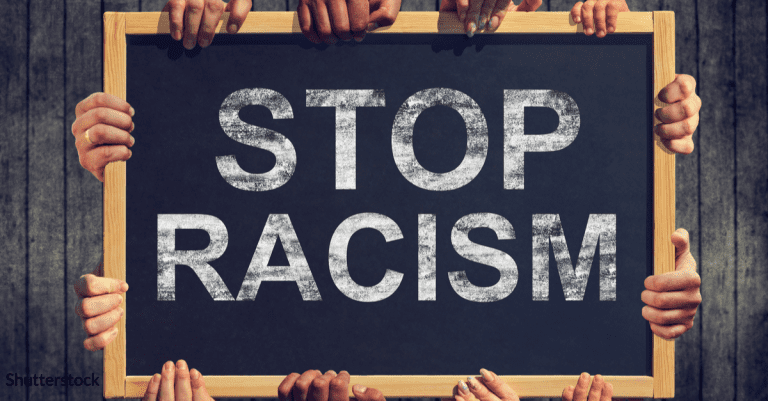
Perhaps the most egregious evidence of systemic racism in America has to do with the issue of mass incarceration. The evidence of racial bias in our criminal justice system isn’t just convincing — it’s overwhelming.
Tim Keller noted: “It is well-known that Black people in the criminal justice system are far more often detained, arrested, and given greater sentences than White people for the same behavior and the same crimes. There are many efforts from the top to reform police departments through policy changes and through creating multi-ethnic police departments. The continuance of the same kinds of incidents of brutality have shown how pervasive and entrenched are the structural aspects of the unequal treatment of non-White people in the criminal justice system.” [1]
Radley Balko notes, “when you consider that much of the criminal justice system was built, honed, and firmly established during the Jim Crow era — an era almost everyone, conservatives included, will concede rife with racism — this is pretty intuitive. The modern criminal justice system helped preserve racial order — it kept Black people in their place. For much of the early 20th century, in some parts of the country, that was its primary function. That it might retain some of those proclivities today shouldn’t be all that surprising.”[2]
Michelle Alexander adds, “No other country in the world imprisons so many of its racial or ethnic minorities. The United States imprisons a larger percentage of its Black population than South Africa did at the height of apartheid.”[3]
African Americans are incarcerated in state prisons across the country at more than five times the rate of Whites, and at least ten times the rate in five states.[4]
Criminal Justice and systemic racism
Though approximately 5% of the world’s population live in the US, the US incarcerates more than 25% of the world’s prisoners.[5] The US has six to ten times more people in prison per capita than any other industrialized nation.[6]
How can it be that the leader of the industrialized world and arguably the greatest nation on earth has so many of its citizens locked up in prisons?
The answer is systemic racism.
The data shows that a significantly disproportionate number of persons of color are incarcerated than Whites.[7]
In the US, one out of every seventeen White males is incarcerated. Whereas, one in every three Black men and one in every six Latino men are incarcerated.
The statistics are the same for Black women as well. One in every one-hundred and eleven White women are incarcerated. Whereas, one in every eighteen Black women and one in every forty-five Latino women are incarcerated.
A 2015 report, by Michael Males, a senior research fellow at the Center for Juvenile and Criminal Justice, found that though Black women in San Francisco account for 45.5 percent of female arrests even though they comprise only six percent of the female population of San Francisco.[8]
The result is that, although African Americans and Latinos make up approximately 32% of the US population, in 2015 they comprised 56% of all incarcerated persons.[9]
A Washington Post article reported that in 2016 the Massachusetts Sentencing Commission found that “Black people in the state are eight times more likely to be incarcerated than White people. Hispanic people were about five times more likely.”[10]
Michelle Alexander notes, “In Washington, DC, our nation’s capital, it is estimated that three out of four young Black men (and nearly all those in the poorest neighborhoods) can expect to serve time in prison.”[11]
Do people of color commit more crimes?
One might attempt to account for the racial disparity in the criminal justice system by claiming that people of color commit more crimes. The evidence does not support the thesis.
The fact is that if a certain people group, say people of color, are pulled over at higher rates than others simply because of their skin color, then is it any wonder that they have a higher rate of arrest?
In their book, Suspect Citizens: What 20 Million Traffic Stops Tell Us About Policing and Race, Frank R. Baumgartner, Derek A. Epp, and Kelsey Shoub reviewed 20 million traffic stops. In reviewing the data, they determined that “Blacks are almost twice as likely to be pulled over as Whites—even though Whites drive more on average.”[12]
Drug use and color
When it comes to drugs crimes the data suggests that Whites use illegal drugs at basically the same rate as people of color.
Alexander notes, “These stark racial disparities cannot be explained by rates of drug crime. Studies show that people of all colors use and sell illegal drugs at remarkably similar rates. If there are significant differences in the surveys to be found, they frequently suggest that Whites, particularly White youth, are more likely to engage in drug crime than people of color. That is not what one would guess, however, when entering our nation’s prisons and jails, which are overflowing with Black and brown people convicted of drug crimes. In some states, Black men have been admitted to prison on drug charges at rates twenty to fifty times greater than those of White men.”[13]
According to the data, although White and Black men use drugs at similar rates, the rate of incarceration for drug crimes for Black men is six times higher than for White men.
When it comes to young people, there is some evidence that suggests that White teens are more likely to engage in drug crime than people of color.[14] A study published in 2000 by the National Institute on Drug Abuse reported that White students use cocaine at seven times the rate of Black students, use crack cocaine at eight times the rate of Black students, and use heroin at seven times the rate of Black students.”[15] Yet, they are incarcerated at lower rates than people of color.
Systemic Racism in sentencing
Not only are people of color far more likely to be pulled over, searched, and even arrested, they are far more likely to be charged with a crime, and after being charged they are far more likely to serve longer sentences than Whites who are convicted for a similar crime.
According to figures from the National Registry of Exonerations (NRE), Black people are about five times more likely to go to prison for drug possession than White people.[16] According to the NRE data, Black people are also twelve times more likely to be wrongly convicted of drug crimes.[17]
This research accounted for controlled variables such as age and prior criminal history. According to the data from the US Sentencing Commission last year found that when Black men and White men commit the same crime, Black men on average receive a sentence of almost 20 percent longer.[18]
to be continued . . .
If you have been blessed by this blog post and would like to see others benefit too, would you please consider giving a tax-deductible contribution to support determinetruth ministries and make possible future posts like this? You may give a tax-deductible gift by following this link
Good news: If you wish to view this blog on your smartphone through the Determinetruth app simply download the “tithe.ly church” app on your smartphone and insert “determinetruth” as the church name you wish to follow. Once it is loaded, simply click on the “blog” icon and they will automatically load.
If you would like to have Rob speak at your church or organization in person or via zoom, please let us know by filling out the contact info on the Contact me tab on this site.
If you would like to share your story, or if you have questions that you would like addressed in future posts, you may submit them in the Contact me tab on this site.
[1] Tim Keller, https://quarterly.gospelinlife.com/the-sin-of-racism/ Last accessed 9-13-20.
[2] https://www.washingtonpost.com/graphics/2020/opinions/systemic-racism-police-evidence-criminal-justice-system/ . Last accessed 9-25-20
[3] Alexander, Michelle. The New Jim Crow (p. 8). The New Press. Kindle Edition.
[4] Ashley Nellis, The Color of Justice: Racial and Ethnic Disparity in State Prisons, The Sentencing Project, June 14, 2016. https://www.sentencingproject.org/publications/color-of-justice-racial-and-ethnic-disparity-in-state-prisons/
[5] https://www.washingtonpost.com/news/fact-checker/wp/2015/07/07/yes-u-s-locks-people-up-at-a-higher-rate-than-any-other-country/; http://news.bbc.co.uk/2/shared/spl/hi/uk/06/prisons/html/nn2page1.stm. last accessed 9-22-20.
[6] http://news.bbc.co.uk/2/shared/spl/hi/uk/06/prisons/html/nn2page1.stm. last accessed 9-22-20.
[7] See: Ashley Nellis, The Color of Justice: Racial and Ethnic Disparity in State Prisons, The Sentencing Project, June 14, 2016. https://www.sentencingproject.org/publications/color-of-justice-racial-and-ethnic-disparity-in-state-prisons/. last accessed 9-22-20. Nellis states, African Americans are incarcerated in state prisons across the country at more than five times the rate of Whites, and at least ten times the rate in five states.
[8] http://www.cjcj.org/uploads/cjcj/documents/disproportionate_arrests_in_san_francisco.pdf . Last accessed 9-25-20.
[9] https://www.naacp.org/criminal-justice-fact-sheet/ last accessed June 4, 2020.
[10] Suspect Citizens: What 20 Million Traffic Stops Tell Us About Policing and Race, Frank R. Baumgartner, Derek A. Epp, and Kelsey Shoub, Cambridge, 2018. See also, https://www.bostonglobe.com/metro/2016/10/20/sjc-chief-probe-sentencing-disparities-for-minorities/44Dxw4qDmqOcKYSGGOpw5I/story.html; cited in https://www.washingtonpost.com/graphics/2020/opinions/systemic-racism-police-evidence-criminal-justice-system/#DrugWar; last accessed 9-25-20.
[11] Alexander, Michelle. The New Jim Crow (p. 8). The New Press. Kindle Edition.
[12] https://www.washingtonpost.com/news/monkey-cage/wp/2018/07/17/what-data-on-20-million-traffic-stops-can-tell-us-about-driving-while-Black/ last accessed 9-25-20.
[13] Alexander, Michelle. The New Jim Crow (p. 8). The New Press. Kindle Edition.
[14] See: “Howard N. Snyder and Melissa Sickman, Juvenile Offenders and Victims: 2006 National Report, U.S. Department of Justice, Office of Justice Programs, Office of Juvenile Justice and Delinquency Prevention (Washington, DC: U.S. Department of Justice, 2006), reporting that White youth are more likely than Black youth to engage in illegal drug sales. See also Lloyd D. Johnson, Patrick M. O’Malley, Jerald G. Bachman, and John E. Schulenberg, Monitoring the Future, National Survey Results on Drug Use, 1975–2006, vol. 1, Secondary School Students, U.S. Department of Health and Human Services, National Institute on Drug Abuse, NIH pub. no. 07-6205 (Bethesda, MD: 2007), 32, “African American 12th graders have consistently shown lower usage rates than White 12th graders for most drugs, both licit and illicit”; and Lloyd D. Johnston, Patrick M. O’Malley, and Jerald G. Bachman, Monitoring the Future: National Results on Adolescent Drug Use: Overview of Key Findings 2002, U.S. Department of Health and Human Services, National Institute on Drug Abuse, NIH pub. no. 03-5374 (Bethesda, MD: 2003), presenting data showing that African American adolescents have slightly lower rates of illicit drug use than their White counterparts.” Cited in Alexander, Michelle. The New Jim Crow (p. 332). The New Press. Kindle Edition.
[15] The National Institute on Drug Abuse, Monitoring the Future, National Survey Results on Drug Use, 1975–1999, vol. 1, Secondary School Students (Washington, DC: National Institute on Drug Abuse, 2000). https://files.eric.ed.gov/fulltext/ED514367.pdf. Last accessed 9-22-20.
[16] http://www.law.umich.edu/special/exoneration/Documents/Race_and_Wrongful_Convictions.pdf. last accessed 9-25-20.
[17] Ibid. http://www.law.umich.edu/special/exoneration/Documents/Race_and_Wrongful_Convictions.pdf. last accessed 9-25-20.
[18] https://www.washingtonpost.com/news/wonk/wp/2017/11/16/Black-men-sentenced-to-more-time-for-committing-the-exact-same-crime-as-a-White-person-study-finds/. Last accessed 9-25-20. See also, https://www.ussc.gov/sites/default/files/pdf/research-and-publications/research-publications/2017/20171114_Demographics.pdf. last accessed 9-25-20.












